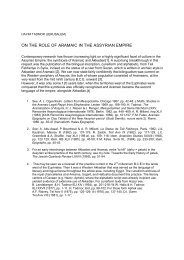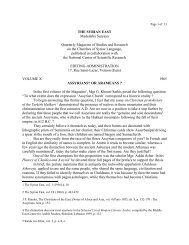The White Syrians Of Aramaean Cappadocia
The White Syrians Of Aramaean Cappadocia
The White Syrians Of Aramaean Cappadocia
You also want an ePaper? Increase the reach of your titles
YUMPU automatically turns print PDFs into web optimized ePapers that Google loves.
*****<br />
A Dictionary of Greek and Roman Geography, Volume II, Pages 171-172.<br />
LEUCOSYRI, the ancient name of the <strong>Syrians</strong> inhabiting <strong>Cappadocia</strong>, by which<br />
they were distinguished from the more southern <strong>Syrians</strong>, who were of a darker<br />
complexion. (Herod. i.72, vii.72; Strabo, xvi. p.737; Pliny, H.N. vi.3; Eustath. ad<br />
Dionys. 772,970.) <strong>The</strong>y also spread over the western parts of Pontus, between the<br />
rivers Iris and Halys. In the time of Xenophon (Anab. v.6,§8&c.) they were united<br />
with Paphlagonia, and governed by a Paphlagonian prince, who is said to have had<br />
an army of 120,000 men, mostly horsemen. This name was often used by the<br />
Greeks, even at the time when it had become customary to designate all the<br />
inhabitants of the country by their native, or rather Persian name, Cappadoces; but<br />
it was applied more particularly to the inhabitants of the coastal district on the<br />
Euxine, between the rivers Halys and Iris. (Hecat. Fragm. 194,200,350; Marcian.<br />
Heracl. p.72.) Ptolemy (v.6§2) also applies the name exclusively to the inhabitants<br />
about the Iris, and treats of their country as part of the province of <strong>Cappadocia</strong>. <strong>The</strong><br />
Leucosyri were regarded as colonists, who had been planted there during the early<br />
conquests of the Assyrians, and were successively subject to Lydia, Persia, and<br />
Macedonia; but after the time of Alexander [<strong>The</strong> Great, RS] their name is scarcely<br />
mentioned, the people having become entirely amalgamated with the nations<br />
among which they lived.<br />
*****<br />
A Dictionary of Greek and Roman Geography, Volume II, Page 1245.<br />
TYANA (Ta Tuana, Tuaneus, Tuanites), also called Thyanan or Thiana, and<br />
originally Tohana, from Thoas, a Thracian king, who was believed to have pursued<br />
Orestes and Pylades thus far, and to have founded the town. Reports said that it was<br />
built, like Zela in Pontus, on a causeway of Semiramis; but it is certain that it was<br />
situated in <strong>Cappadocia</strong> at the foot of Mount Taurus, near the Cilician Gates, and on<br />
a small tributary of the Lamus. It stood on the highroad to Cilicia and Syria at a<br />
distance of 300 stadia from Cybistra, and 400 stadia from Mazaca.<br />
Its situation on that road and close to so important a pass must have rendered Tyana<br />
a place of great consequence, both in a commercial and a military point of view.<br />
<strong>The</strong> plain around it, moreover, was extensive and fertile, and the whole district<br />
received from the town of Tyana the name of Tyanitis.<br />
From its coins we learn that in the reign of Caracalla the city became a Roman<br />
colony; afterwards, having for a time belonged to the empire of Palmyra, it was<br />
conquered by Aurelian, in A.D. 272, and Valens raised it to the rank of the capital<br />
of <strong>Cappadocia</strong> Secunda. Its capture by the Turks is related by Cedrenus.










